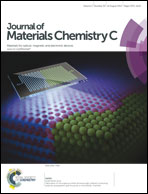Switchable dielectric behaviour associated with above room-temperature phase transition in N-isopropylbenzylammonium dichloroacetate (N-IPBADC)†
Abstract
A bulk transparent single-crystal of N-isopropylbenzylammonium dichloroacetate (N-IPBADC) with sizes of 15 × 15 × 10 mm3, which possesses switchable dielectric permittivities above room temperature, has been successfully grown by the slow solution cooling method. A reversible second-order solid-state phase transition at 366 K was confirmed by thermal analyses, including differential scanning calorimetry (DSC) and specific heat (Cp), dielectric measurements, variable-temperature single-crystal X-ray diffraction and powder X-ray diffraction (PXRD). In particular, order–disorder transformations of the dichloroacetate moieties in N-IPBADC from room temperature to high temperature phases have been revealed to induce the distinct dielectric anomaly along with dielectric anisotropic properties above room temperature, up to 366 K. The successful discovery of N-IPBADC would potentially pave a new way to explore new above room-temperature phase transition materials.


 Please wait while we load your content...
Please wait while we load your content...